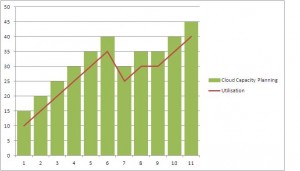| Capacity planning is the thing that stands out as the biggest advantage of the Microsoft cloud model. The Windows Azure platform takes that out of the equation for us, unlike the other cloud providers. | ||
| Jonathan Malek Chief Architect and Director of Research, Associated Press |
The above quotation is taken from a Microsoft case study http://www.microsoft.com/casestudies/Case_Study_Detail.aspx?casestudyid=4000005887
But is it REALLY true?
In another part of the Microsoft website, they say
See how Windows Azure helped the AP develop a new global API through easy scalability that removed the need for costly and time-consuming capacity planning. http://www.microsoft.com/en-us/cloud/tools-resources/casestudy.aspx?resourceId=Associated_Press&fbid=Be4qy4YrM4Q
Looking at the first quotation, it is possible to unpick the words to get at the truth. Simply moving from in-house IT infrastructure onto a "cloud" merely shifts the effort of Resource Capacity Management (that is: managing the infrastructure) from the business over to the Cloud provider. Business and Service Capacity Management (that is: managing the business and service quality) still needs to be done. Someone has to work out when the existing deployment will become insufficient to provide a good quality of service and therefore needs to be upgraded. Being in a "Cloud" merely means that this has apparently become the job of the "Cloud" provider, rather than the business owner.
But wait, (I hear you cry), my "Cloud" provider has shown me the graphs that explain how being in the "Cloud" means that I will always have exactly the capacity I need on demand. A typical graph that is shown by the salesmen and marketeers is like this:
Capacity Planning traditionally provides the resource that the business needs in a timely manner. 'Cloud' providers will point to the area above the line to show that capacity has been purchase that isn't immediately used. They will tell you how this is wasteful.
Instead, they will champion their own solution:
The 'Cloud' provider will now show how, by always providing a set percentage MORE capacity than is actually required, they can maintain that margin of "headroom" and thereby save the business a lot of money.
Now, I would ask..
What happens when an application goes 'rogue'?
In the traditional Capacity Planning model, a rogue process will continue to consume resources until it fills a system. At this point, the support teams will hopefully notice something and restart the application. However, in the 'Cloud' model, the rogue process will consume all resources until it reaches the "headroom" margin that has been set. The 'Cloud' will then give the application even more resource, which the application will consume, at which point the 'Cloud' will give even more resource.. which will be consumed. This will never end.
Of course... this would never happen, would it? After all, the Cloud provider would never just shovel more resources at a rogue application? Well. Unless there is someone manually checking things, then how will they ever tell the difference between an application going rogue, and the business being highly (and suddenly) successful? Imagine the launch of the Ipad 3. That will generate a huge hit on eCommerce systems that will certainly look like a rogue process, but will actually be many millions of people wanting to be the first to order/own the device.
Given the first quotation at the very top of this article, I can agree to a limited extent that "The Windows Azure platform takes that [Capacity Planning] out of the equation for us". Of course it has taken some of the Capacity Planning out of the equation for the customer... because predicting IT resources now resides on the desk of the 'Cloud' supplier. They are the ones that need to judge whether the sudden increase in activity is down to a rise in business activity, or due to a failure of an application. However they aren't privvy to any business forecasts.
The only sure-fire way of knowing in advance which of the two it is, is by Capacity Management. You see, Capacity Management isn't some "Techno-geek" activity that is buried in the dungeons of a production support team. Capacity Management is the activity that links the Business Planning to the IT department. It seems strange that businesses should go to all that trouble of actually planning what they are going to do, how they are going to do it, and why, only for the IT department to ignore all of that meticulous planning and just guess that the 'Cloud' will be able to support them. In fact. I would suggest that it is the attitude of the 'Cloud' providers that is going to end up being "costly and time consuming" to the business.
How will the business ever plan its budgets without a clear idea of the future IT expenditure? If a business cannot plan its outgoings, then how will it know whether a particular product or service is going to be profitable? The IT department aren't going to be much help with this, because they have washed their hands of any Capacity Management and now at the mercy of the reactive model imposed upon them by the 'Cloud' provider.
Microsoft claim that their 'Cloud' provides "easy scalability that removed the need for costly and time-consuming capacity planning". I would advise this: You'll only really comprehend the VALUE of capacity planning, when you suffer the COST of not doing it.


